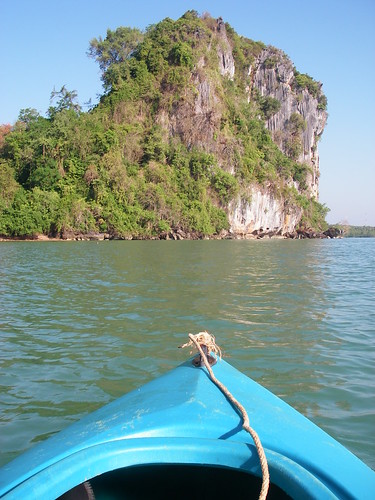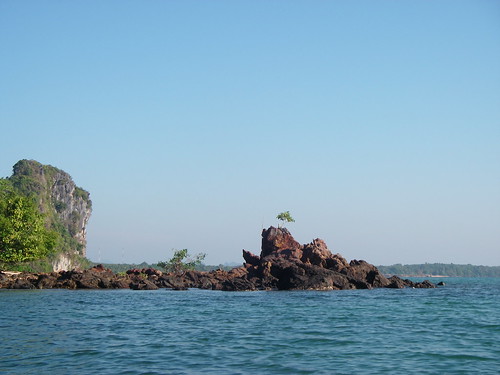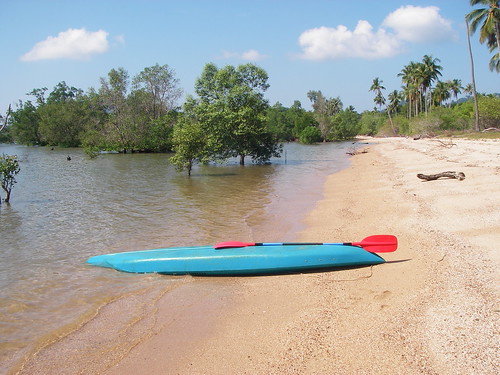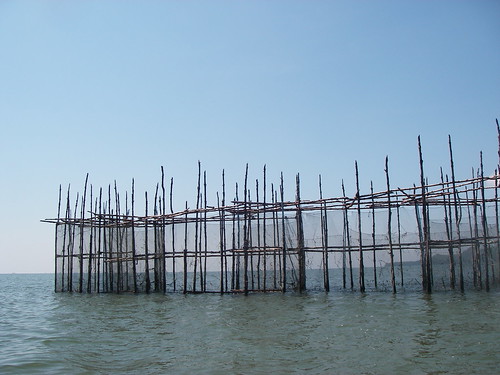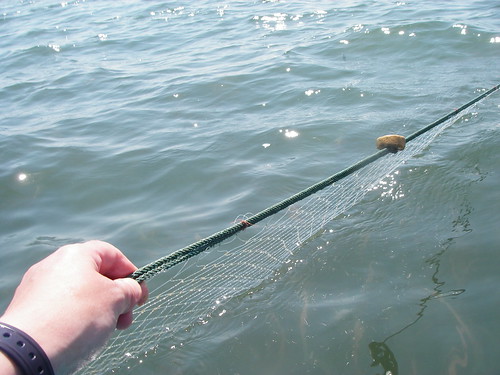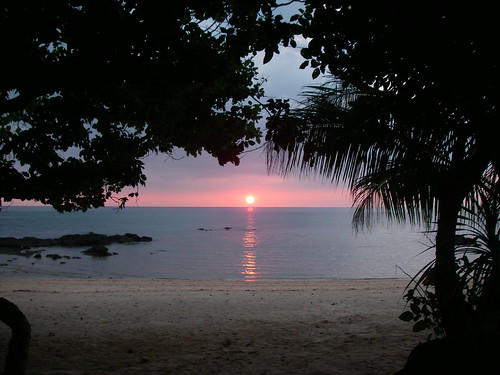Girl’s Own Adventure: Kayak Survey
On the map at reception, the the dugong habitat looked to be around the corner from the Libong Nature Beach Resort, clearly marked in the bay off Na Barn village. I paddled into the calm morning with optimism, but when I reached the outcrop of rocks that marked the end of the resort’s beach, it turned out that this was not the island’s southern tip—far from it. The outcrop opened up into another secluded bay and, after that, another.
I remembered the three ‘secret’ beaches that could be explored by kayak or mountain bike as detailed on the wall posters next to the reception. The map was a much smaller scale, making the distance to Na Barn village and the bay of the dugongs appear closer. I had still some way to paddle, but it didn’t matter. It was still cool—I’d climbed into the boat just after 7:30—and the sea was mirror-calm.
I watched out for movements on the surface, but the spectacular coastline kept drawing my gaze.
It took over an hour’s paddling before I finally reached the eastern side of the island. Almost immediately, I spotted the first seagrass bed. Heart pounding I slowed down but the water was too turbid to make out any feeding tracks. Had I thought of measuring the depth, I would have found that it was probably too shallow for dugongs. One of the figures in the survey report1 shows the depth around large parts of Libong to be 70cm or less.
The sea had freshened up to a State Two, the bay rippling with gentle wavelets, although there was no noticeable breeze. At 9:21 I saw a dolphin-sized splash somewhere in the middle of the bay, and eight minutes later another. Were there dolphins here, so close to shore? Do dugongs jump? Seals do sometimes, so why not dugongs?
Another hour’s paddling followed. By now the sun had climbed high into the sky and the village of Na Barn lay a long way behind me. Cursing, I had circled its ridiculously long pier—stretching at least half a mile into the bay—and crossed from there diagonally back to shore to find that I had already passed most of the village, including anything that might have been a shop or noodle house. There was no seagrass there, just shallow mud, and I felt cheated.
I took a sip from my water bottle and chewed on a stick of fruit leather, turning away from the sun to find myself looking at a stretch of golden sand behind the mangroves.
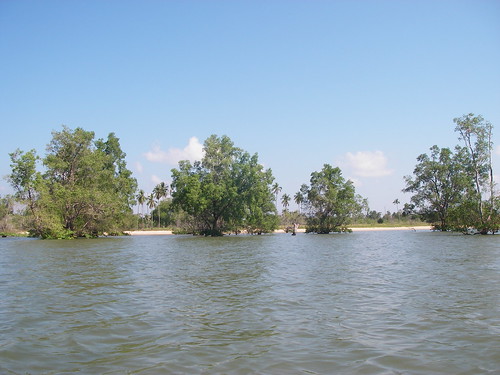
It took an inordinate time to paddle to shore. The bay was spiked with sticks, placed seemingly at random. Their purpose escaped me. Maybe people clambered up on them them to fish as they do in Sri Lanka, but the sticks looked too spindly for that.
Besides, there was not a soul to be seen. I had seen a boat exit from what looked like a small estuary past the mangrove beach, but it had turned the other way, heading towards the norther tip.
I needed a break. The whole place looked surreal and the sun was getting brutal. I wished I’d brought my hat.
Paddling on, hundreds of yards from shore, I hit sand with the edge of my blade. I could get out of the boat and the water would only come up to just above my ankles. But I found the paddling easier now. The kayak glided centimetres above the sandy bottom and hit the beach with a soft hiss.
When I climbed out, I nearly fell over. With each stroke, a rivulet of water had run down the paddle and accumulated in the boat, unbalancing it. I heaved the thing over to empty it out, but only succeeded in adding a load of coarse sand to the water inside.
Shrugging, I found a bleached log to sit on, took out my butt bin and lit a cigarette. As far as the eye could see there were no people here and there was no shade.
My legs had started to turn red, despite the sunscreen. I slathered on another load and regarded them for a while. Long trousers might have been a good idea.
The sun was as hot as in the Sinai. Remembering my desert clothes, I took out my purple towel and placed it on my head. The edges caught the slightest whispers of air and for a moment it almost felt as if I was sitting under a shelter.
After another cigarette it was time to go. Refreshed, I decided to paddle away from shore to look for the seagrass lawns. But the estuary lured me across. I had heard that the dugongs sometimes swim among the mangroves. Manatees certainly do—they need access to freshwater—and it brought back memories of Trinidad.
But I didn’t get far until I ran up against a fence of sticks.
What was it with these sticks? What purpose did they serve?
That became clear soon enough. Running from right between the mangroves, the fences formed funnels leading up to a fishtrap further away from shore. The water was so shallow that the dugongs could not possibly end up in there, so this way of fishing did not seem to interfere with them.
I paddled around the damn thing, relieved when I finally found myself over seagrass again, right in the middle of the bay, opposite a little islet that I took to mark its northern boundary. According to the map, I was slam-bang in the middle of dudong habitat.
I stuck the paddle vertically into the water. The depth was about 70 cm.
There was another mighty splash ahead. I held my breath, but nothing else followed. If that was a fish, it must have been a monster.
It’d been over four hours since I’d started my little adventure (so much for a half-day hire), so I decided to paddle up to the little island and do a transect from there straight back to the limestone cliff and rocky outcrop that marked the southern tip of the bay. The water ought to be deeper there.
Grey shadows drifted underneath the boat. At first I took them to be dugongs, but they were static. I thought they were rocks, but then it became apparent that they were patches of seagrass growing on the muddy bottom. My vision of a green undersea lawn with dugongs floating in the crystal waters above, faded. It was silty, with a visibility of maybe 20 centimetres, and the seagrass was covered with algae and debris.
At six minutes to twelve there was another mighty splash ahead.
I continued paddling for another half hour. The island got no closer, but the bottom did. Soon I could touch it with my fingertips. I decided to paddle up level with the island, then turn around and start the transect from there.
At my chosen point I looked down. The water was deeper and the seagrass was back. And there was something else…
A rope. No, a net.
I grabbed hold of it and tugged. The net sat firm, stretching ahead, and back towards the islet.
A net here in the no-fishing-zone, in the middle of dugong habitat. I did my paddle test again. The depth was about 1.2 m.
I lifted the net up on the other side, to take a picture with the islet in the background for reference, when I spotted a boat drifting just offshore in what must be finger-deep water. The net stretched towards it.
I could be in trouble here.
Suddenly angry, I decided to turn back. With this sort of activity going on, I could only hope that there were no dugongs around.
Barely fifteen minutes later the waves picked up without warning. The first whitecaps started to appear. I was in denial, but the sea built irrevocably up to a State Three. If I paused for just a moment, I would be going backwards.
Hands burning, my seat full of water like warm piss—with more sloshing over the bow whenever I misjudged my position even slightly—I paddled on, trying to keep strong regular strokes. There was no point in looking out. Unless something jumped into the boat, I wouldn’t see it.
Something almost did. My bow cut through the remnants of yet another splash. I heard what sounded like two snorts in quick succession.
I paused but there was nothing more, and I had started to drift. Reasoning took over. They don’t call these things Sirenia for nothing.
I paddled on. The distant shore crept past so slowly that I seemed to be standing still. At long last Mangrove Beach came into view. Oh great: it had only been an hour’s paddle from there to the cursed village pier…
It would be a lot longer now. The beach grew no bigger and the village was nowhere yet in sight.
The waves became solid things. Multifaceted diamonds winked at me, hypnotised me, alternately carrying me along and wanting to draw me beneath the shimmering surface.
The pier became my goal. I would stop and hold on for a while, have a sip of water, perhaps get out of the boat. It danced in front of my eyes like a mirage whenever I looked to shore. A line that didn’t seem solid, but it had to be there. It was far, and I was far out. I remembered the long approach to Mangrove Beach. Would it be worth it?
It would. There might be a tea house. And at worst there would be help.
But when I turned towards it, it got shallower, quickly. I could see the muddy bottom. The waves were less, but the going was no easier. When I stopped to take a swig of water I saw things rush across the mud and it took me a while to realise that it was the bottom itself drifting underneath me.
There could be no breaks.
I turned back and, at long last, the limestone cliff came into view. I remembered how long it had taken me to paddle around the southern tip—a good hour—but I had been much closer to shore, following the rocky outcrops. If I stayed further out it should be quicker, and the wind should lessen once I turned north. Perhaps it would even push me along.
I reached the damn cliff just after twenty past three, two hours since my mad paddling began. One of the three ‘secret beaches’ came into view, but it didn’t get easier. Nothing moved. Paddle as I might, I was stationary with regard to shore.
One of the fishing boats that were buzzing between the villages and the creel markers that dotted the water pulled up.
“You OK?”
I gritted my teeth.
“Fine!” I shouted and gave what I thought to be a cheerful wave before hastily grabbing the paddle again.
“OK.”
But the boat stayed close, its skipper pretending to look elsewhere. At last he took off at speed, towards Ko Sukorn. I shook my head and looked at the beach again.
It was no longer stationary.
Progress was slow. Behind every outcrop, I knew, there would be another. Until a stretch of golden sand crept into view and I nearly let out a yell.
But I wasn’t home yet. It was the first of the ‘secret beaches’, or what I prefer to call False Beach..
When I finally turned north, I found myself once again stationary with regard to shore.
By now the resort was in view. I turned towards it and was rocked by another wave. I turned the boat back out and paddled until I was almost level with the beach bar, then repeated the exercise.
And again. And again.
There was no point in fighting the current. I let it take me.
Kayaking, I discovered, is a lot like sailing. I could not go straight against the wind or the current. I had to permit them to carry me out and approach my goal at an angle.
I wondered if people were watching me from the bar and thought that I was crazy, or trying to steal one of the kayaks. So what?
I overshot the resort by some distance, then turned around and rode in with the swell. Gently, very gently.
By the time I touched sand, the sun was low in the sky. It was five thirty. My little adventure had lasted almost ten hours.
And I had no idea whether I’d actually seen a dugong…
*
After that little jaunt, I needed a rest.
“You’re in luck,” the Professor said when I staggered into the bar. “I’ve got five people who want to do a dugong tour tomorrow. I think they can fit you in.”
1http://www.warthai.org/files/AerialSurvey_Jan%202008.pdf
Tags: Dugongs, SE Asia, Travel, Tag Index